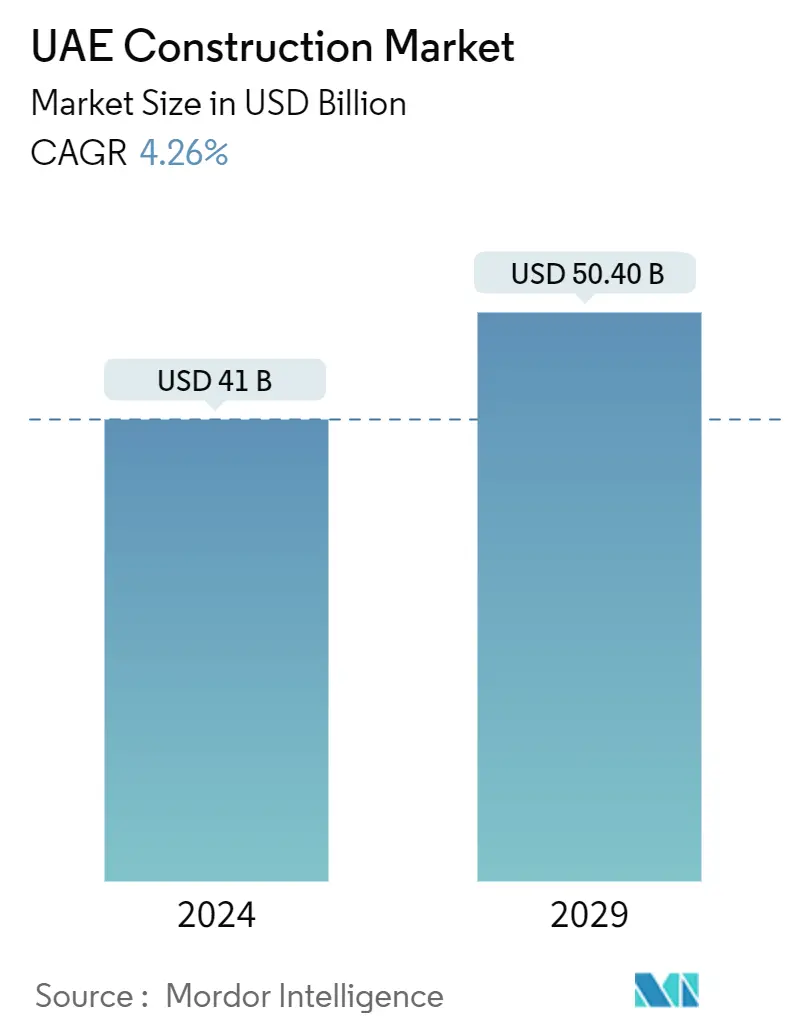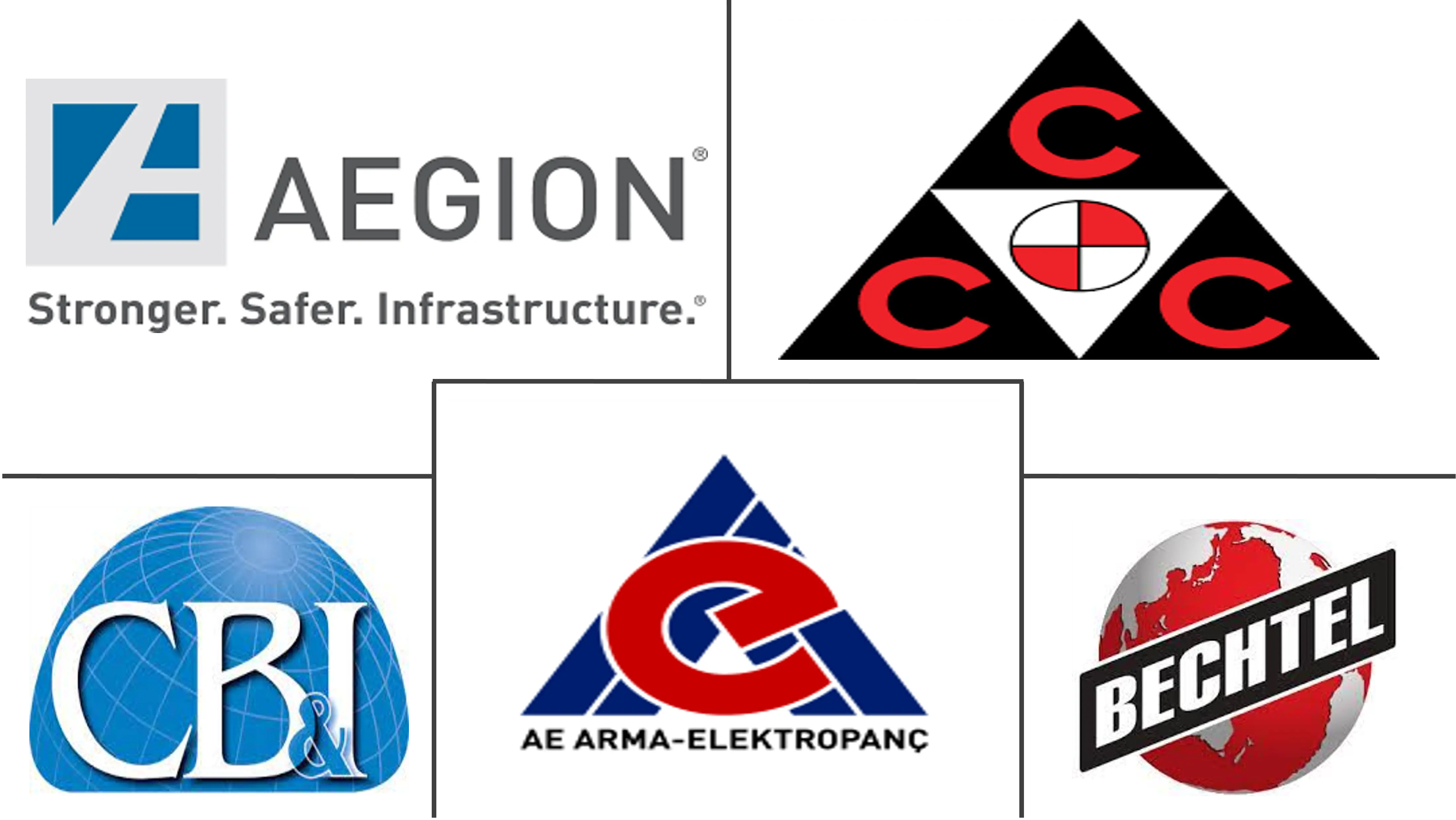Market Size of UAE Construction Industry

| Study Period | 2020 - 2029 |
| Base Year For Estimation | 2023 |
| Market Size (2024) | USD 41 Billion |
| Market Size (2029) | USD 50.40 Billion |
| CAGR (2024 - 2029) | 4.26 % |
| Market Concentration | Medium |
Major Players
*Disclaimer: Major Players sorted in no particular order |
UAE Construction Market Analysis
The UAE Construction Market size is estimated at USD 41 billion in 2024, and is expected to reach USD 50.40 billion by 2029, growing at a CAGR of 4.26% during the forecast period (2024-2029).
COVID-19 affected the construction market in Dubai, leading to a temporary suspension of work and reducing the net profit of the industry. The government is concentrating on smart cities and plans to digitize up to 1,000 government services and put more than 2,000 wireless hotspots in place.
Liberal trade policies in the country are attracting foreign investors and boosting the UAE construction market. The construction industry is the core of the UAE economy, and it expects rapid growth in the coming years. The construction industry plays a vital role in the economic upliftment and development of the country.
The United Arab Emirates focuses on economic diversification to lessen its dependency on the oil and gas sector. The country has been adopting long-term growth strategies, and the construction industry is turning to prefabricated buildings.
The United Arab Emirates has various transportation infrastructure projects under construction, such as the USD 2.7 billion Sheikh Zayed double-deck road scheme. It also has unconventional transport projects, such as the USD 5.9 billion proposed hyperloop project between Dubai and Abu Dhabi.
Smart cities are evolving increasingly as governments worldwide look for solutions to ensure more environmentally friendly and effective infrastructure development. To provide better living conditions to the residents, buildings, green areas, and public services must all remain connected to a single automated infrastructure. These shifts prompted the building and industrial industries to adopt new technology and seek more sustainable and computerized alternatives.
Moreover, with ongoing investment and technological advancements, the country is investing in diverse projects. These large-scale investments aim to provide housing opportunities for lower-income groups, create new employment, and diversify the country's economy.
The UAE construction sector is expected to attain moderate post-pandemic growth in the coming years. The UAE government is focusing on investment in energy and infrastructure, including utilities, decarbonization, transportation, renewable and nuclear energy generation, and fixing the ongoing water scarcity. The region's significant commitment and resources indicate various mega-project opportunities for construction and engineering companies.
Recent project announcements in the country include the Dubai Municipality's plan to build a strategic sewerage tunnel, Abu Dhabi National Oil Company's (ADNOC) Al-Nouf seawater treatment plant, and other mega construction projects like the redevelopment of Mina Rashid in Dubai and the Dubai International Financial Centre Expansion 2.0.
UAE Construction Industry Segmentation
The construction market includes several activities covering upcoming, ongoing, and growing construction projects in different sectors. It has but is not limited to geotechnical (underground structures) and superstructures in residential, commercial, and industrial systems, infrastructure construction (like roads, railways, and airports), and power generation and transmission-related infrastructure.
A complete background analysis of the UAE construction market, including the assessment of the economy and contribution of sectors in the economy, market overview, market size estimation for key segments, and emerging trends in the market segments, market dynamics, and geographical trends, and COVID-19 impact, is covered in the report.
The UAE construction market is segmented by sector (commercial construction, residential construction, industrial construction, infrastructure (transportation) construction, and energy and utility construction). The report offers market size and forecasts for all the above segments in value (USD).
| By Sector | |
| Commercial Construction | |
| Residential Construction | |
| Industrial Construction | |
| Infrastructure (Transportation) Construction | |
| Energy and Utilities Construction |
UAE Construction Market Size Summary
The United Arab Emirates construction market is poised for significant growth, driven by strategic government initiatives and economic diversification efforts. The sector is a cornerstone of the UAE's economy, with a focus on smart city developments and infrastructure projects that aim to reduce reliance on oil and gas. The government's commitment to digitization and sustainable urban development is evident in its plans to implement smart technologies and prefabricated building solutions. This shift is further supported by liberal trade policies that attract foreign investment, enhancing the competitive landscape of the construction industry. The market is characterized by substantial international presence and consolidation, with major players actively participating in lucrative projects across the region.
The construction industry in the UAE is expected to experience moderate growth in the post-pandemic period, with ongoing investments in energy, infrastructure, and transportation sectors. Mega-projects such as the Sheikh Zayed double-deck road scheme and the proposed hyperloop project between Dubai and Abu Dhabi highlight the country's ambitious infrastructure goals. Additionally, the UAE's strategic position as a trade hub in the Middle East continues to attract significant construction activities, contributing to the sector's expansion. Despite challenges, such as a lower pipeline value compared to ongoing projects, the market remains robust, with numerous opportunities for construction and engineering companies to capitalize on the country's economic growth and diversification strategies.
UAE Construction Market Size - Table of Contents
-
1. MARKET INSIGHTS
-
1.1 Current Economic and Construction Market Scenario
-
1.2 Technological Innovations in the Construction Sector
-
1.3 Insights into Supply Chain/Value Chain Analysis
-
1.4 Impact of Government Regulations and Initiatives on the Industry
-
1.5 Impact of COVID-19 on the Market
-
-
2. MARKET SEGMENTATION
-
2.1 By Sector
-
2.1.1 Commercial Construction
-
2.1.2 Residential Construction
-
2.1.3 Industrial Construction
-
2.1.4 Infrastructure (Transportation) Construction
-
2.1.5 Energy and Utilities Construction
-
-
UAE Construction Market Size FAQs
How big is the UAE Construction Market?
The UAE Construction Market size is expected to reach USD 41 billion in 2024 and grow at a CAGR of 4.26% to reach USD 50.40 billion by 2029.
What is the current UAE Construction Market size?
In 2024, the UAE Construction Market size is expected to reach USD 41 billion.

